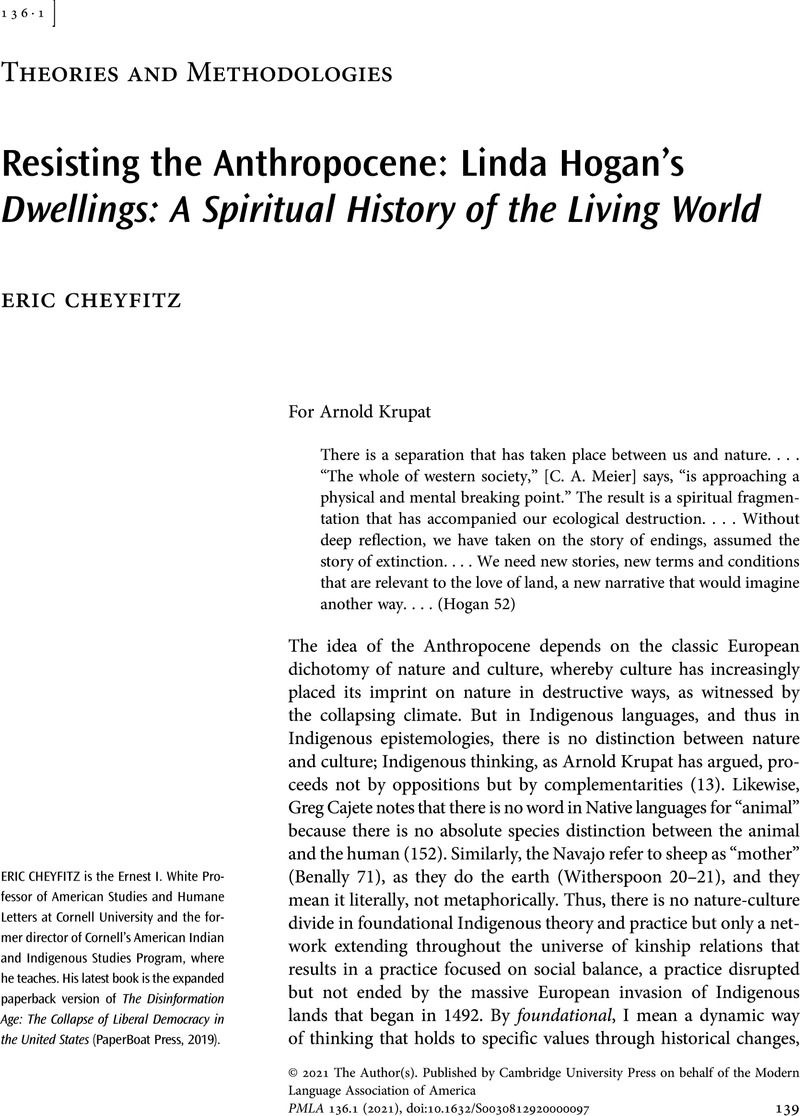No CrossRef data available.
Article contents
Resisting the Anthropocene: Linda Hogan's Dwellings: A Spiritual History of the Living World
Published online by Cambridge University Press: 27 January 2021
Abstract
An abstract is not available for this content so a preview has been provided. Please use the Get access link above for information on how to access this content.

- Type
- Theories and Methodologies
- Information
- Copyright
- Copyright © 2021 The Author(s). Published by Cambridge University Press on behalf of the Modern Language Association of America
References
Works Cited
Anson, April. “‘Master Metaphor’: Environmental Apocalypse and the Settler State(s) of Emergency.” Roots of the Future, special issue of Resilience, vol. 8, no. 1, Winter 2020–21. Forthcoming.Google Scholar
Benally, Malcolm D., editor and translator. Bitter Water: Diné Oral Histories of the Navajo-Hopi Land Dispute. U of Arizona P, 2011.Google Scholar
Bevis, William. “Native American Novels: Homing In.” Recovering the Word: Essays on Native American Literature, edited by Swann, Brian and Krupat, Arnold, U of California P, 1987, pp. 580–620.Google Scholar
Cajete, Gregory. Native Science: Natural Laws of Interdependence. Clear Light Books, 1999.Google Scholar
Centellas, Miguel. “Bolivia's New Multicultural Constitution: The 2009 Constitution in Historical and Comparative Perspective.” Latin America's Multicultural Movements: The Struggle between Communitarianism, Autonomy, and Human Rights, edited by Eisenstadt, Todd A. et al. , Kindle ed., Oxford UP, 2013.Google Scholar
Cheyfitz, Eric. The Disinformation Age: The Collapse of Liberal Democracy in the United States. Updated ed., PaperBoat Press, 2019.Google Scholar
Constitution of the Plurinational State of Bolivia: Enacted on February 7th, 2009 by President Evo Morales Ayma. Translated by Luis Francisco. Typescript.Google Scholar
Daszak, Peter. Interview by Amy Goodman. Democracy Now, 16 Apr. 2020, www.democracynow.org/2020/4/16/peter_daszak_coronavirus. Transcript.Google Scholar
Estes, Nick. Our History Is the Future: Standing Rock versus the Dakota Access Pipeline, and the Long Tradition of Indigenous Resistance. Verso, 2019.Google Scholar
Gilio-Whitaker, Dina. As Long As Grass Grows: The Indigenous Fight for Environmental Justice from Colonization to Standing Rock. Beacon Press, 2019.Google Scholar
Hogan, Linda. Dwellings: A Spiritual History of the Living World. Simon and Schuster, 1996.Google Scholar
El Kilombo Intergalactico. Beyond Resistance: Everything, an Interview with Subcomandante, Insurgente Marcos. PaperBoat Press, 2007.Google Scholar
Krupat, Arnold. All That Remains: Varieties of Indigenous Expression. U of Nebraska P, 2009.Google Scholar
Picq, Manuela. “Evading Indigenous Consultation in Bolivia.” Al Jazeera, 14 Sept. 2011, www.aljazeera.com/indepth/opinion/2011/09/201197105514717750.html.Google Scholar
Safi, Michael. “Suicides of Nearly Sixty Thousand Indian Farmers Linked to Climate Change, Study Claims.” The Guardian, 31 July 2017, www.theguardian.com/environment/2017/jul/31/suicides-of-nearly-60000-indian-farmers-linked-to-climate-change-study-claims.Google Scholar
Scranton, Roy. Learning to Die in the Anthropocene: Reflections on the End of Civilization. Kindle ed., City Lights Books, 2015.Google Scholar
Vizenor, Gerald. Manifest Manners: Narratives on Postindian Survivance. U of Nebraska P, 1999.Google Scholar
Wolfe, Patrick. “Settler Colonialism and the Elimination of the Native.” Journal of Genocide Research, vol. 8, no. 4, Dec. 2006, pp. 387–409.Google Scholar


